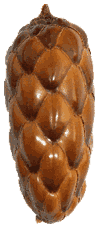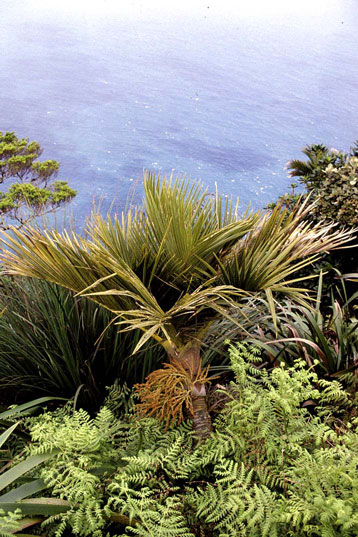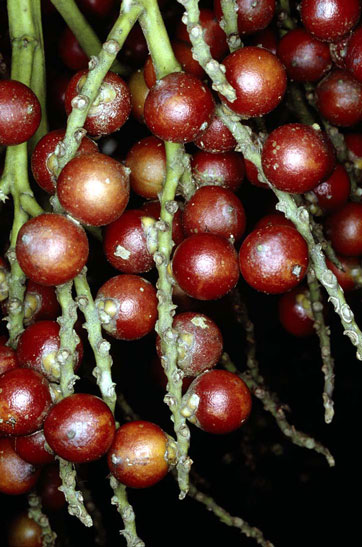 |
Palm |
 |
Palm |
 |
| Lepidorrachis mooreana, growing on exposed cliffs on Lord Howe Island. (Photo: Bill Baker) |
Lepidorrhachis mooreana is restricted to the summits of Mt. Gower (875 m) and Mt. Lidgbird (777 m) on the remote Lord Howe Island. It occurs only above 750 m in dwarf mossy forest that dominates the summit plateau of Mt. Gower and the narrow summit ridge of Mt. Lidgbird. This forest is home to numerous remarkable endemic species including the pumpkin tree (Negria rhabdothamnoides), an arborescent member of the Gesneriaceae, and Dracophyllum fitzgeraldii (Ericaceae). It is also the primary nesting locality of the providence petrel (Pterodroma solandri) and is a stronghold for the woodhen (Tricholimnas sylvestris), an endemic member of the rail family that was recently rescued from the brink of extinction. However, less that 0.5 km2 of Lord Howe’s total surface area of 12 km2 is found above 750 m. The total area of suitable habitat available to Lepidorrhachis is thus extremely limited.
 |
| Ripe fruits of Lepidorrachis mooreana.
(Photo: Bill Baker) |
Lepidorrhachis is very easily distinguished from the two other endemic palm genera on Lord Howe Island, Howea and Hedyscepe. It is a short solitary palm with a stem that rarely exceeds 2 m in height. It has stiff, arching leaves with short, deeply split leaf sheaths that do not form a distinct crownshaft. The sheaths are also covered with buff indumentum. Its bushy inflorescences are born below the leaves and are unisexual, both male and female inflorescences occurring on the same plant.
Little is known of the natural history of this palm. Despite the existence of intact vegetation below 750 m, Lepidorrhachis remains restricted to high elevation mossy forest, suggesting that it is unable to survive in forest types at lower elevations.
Introduced rats (Rattus rattus) are common throughout the island and eat the fruits to such an extent that regeneration is prevented. This has led to apparently uneven age structure within the populations. Only in areas recently baited to control rats has there been any significant initiation of seedling recruitment.
The small area of the summit forest leaves the populations of Lepidorrhachis vulnerable to stochastic events such as fire or landslips. Population regeneration is likely linked to small scale storm disturbance and tree death, but larger scale disturbances could be catastrophic. The fragile soil and vegetation are also vulnerable to damage by human visitors to the plateau. One potential threat linked to humans is the introduction of the pathogen Phythophthora cinnamomi that could impact on a number of structural dominants in the cloud forest.
Invasive, introduced weed species pose a severe threat to the vegetation of Lord Howe Island. The intact, dense canopy cover on the summit of Mount Gower discourages invasion by weeds, most of which establish from seed when a canopy break occurs. At present, weeds are not a problem for Mount Gower summit, however Mount Lidgbird has a more open forest structure and weeds could pose a threat.
The most insidious threat is posed by climate change, which could effect the semi-permanent cloud cover which creates the climate necessary for the survival of the mossy forest. A small increase in the height of the cloud base would very likely have a catastrophic effect on this vegetation and the organisms that depend upon it.
The entire distribution of Lepidorrhachis falls within a permanent park preserve, which is also part of the Lord Howe Island UNESCO World Heritage Site. Tourists are permitted to visit the plateau only when accompanied by an approved guide.
The Lord Howe Island Board actively applies rat control measures in some parts of the Mt. Gower summit plateau. In these areas, Lepidorrhachis fruits and regenerates well. However, rat control extends only to a small part of the palm’s limited distribution.
Over the past four years the LHI Board have developed a comprehensive weed strategy and plans are being made to extend this strategy to the mountains in the south of the island.
Lepidorrhachis has become the focus of several related conservation research projects. Demographic studies are currently taking place (Hutton & Auld) to evaluate the impacts of rats on regeneration. A detailed population census, demographic mapping and phenological survey will be undertaken in 2007 (Shapcott, Hutton & Auld) to determine the effective population size and assess population viability. The potential effects of climate on reproductive timing will be initially investigated by assessing the synchrony of phenological activity within and among populations especially in relation to altitude (Shapcott, Hutton & Auld). A survey of the genetic diversity within the species will investigate the differentiation between the two mountain top populations and will evaluate whether species is genetically depauperate or diverse enough to enable potential long term viability.
A complete rat eradication program is currently under consideration by the Lord Howe Island Board. Though complex to implement, this ambitious plan would be very beneficial for Lepidorrhachis.
Dr. Tony Auld, New South Wales National Parks and Wildlife Service, Australia
Mr. Ian Hutton, Lord Howe Island, Australia
Dr. Alison Shapcott, University of the Sunshine Coast, Queensland, Australia
Dr. William J. Baker, Royal Botanic Gardens, Kew, UK
Baker, W.J. & I. Hutton. 2006.
Lepidorrhachis.
Palms 50: 33–38.
Green, P.S. 1994.
Arecaceae
Flora of Australia 49 (Oceanic Islands 1): 407-412
Hutton, I. 1986.
Lord Howe Island
Conservation Press, Australian Capital Territory
Hutton, I. 1998.
The Australian Geographic Book of Lord Howe Island
Australian Geographic, Terrey Hills, Australia
Hutton, I. 2002.
A Field Guide to the Plants of Lord Howe Island
Published by the author, Lord Howe Island.
Johnson, D. (Ed.) 1996.
Palms – Their Conservation and Sustained Utilization
IUCN, Gland, Switzerland
Pickard, J. 1983.
Vegetation of Lord Howe Island
Cunninghamia 1: 133-366